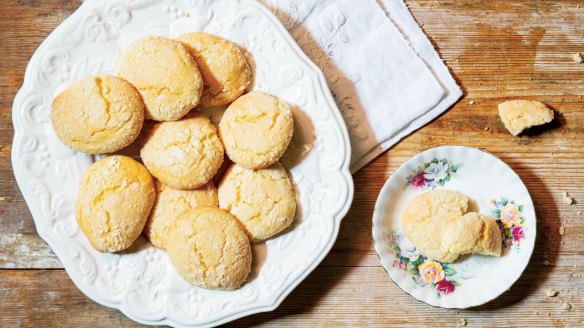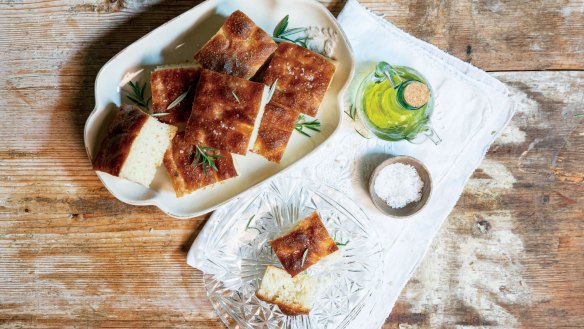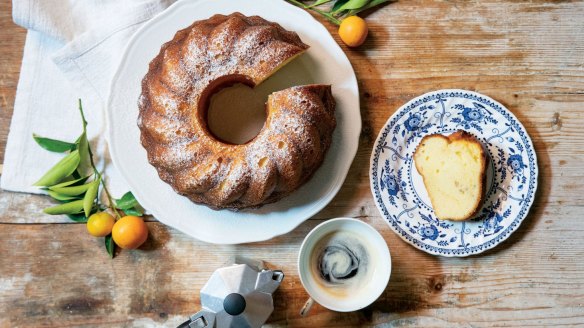Three simple Sicilian family recipes to bake and enjoy

In his cookbook Siciliano, Melbourne chef Joe Vargetto writes that his family's food traditions followed him to school. Like many children of migrants, the contents of his school lunch box were a source of fear and fascination to his classmates.
Rather than food that featured in TV commercials, lunch was often leftovers from the night before, using produce grown in his family's suburban backyard.
"Now the kind of food in my home-made school lunches is fashionable and desirable. It turns out that my green plastic 1970s lunch box was actually a modern-day gourmet hamper."

And while Siciliano records dishes Vargetto learnt while working alongside great chefs such as Philippe Mouchel and Gualtiero Marchesi in Milan, his family's food traditions continue to follow him to his Melbourne restaurants Mister Bianco and Massi.
These three recipes are based on his late mother's notebook.
Sponge fingers
These biscuits were a family recipe but Mum never wrote any complete recipes down, just a list of ingredients that she would measure by hand. So, this recipe is as close to hers as I could get it.
INGREDIENTS
- 4 eggs, separated
- 135g caster sugar
- 60g (4 tbsp) baker's flour
- ½ tsp baking powder
- 100g icing sugar
METHOD
- Preheat oven to 180C fan-forced (200C conventional).
- Line two 43x30cm baking trays with baking paper. Fit a large pastry bag with a 12mm round tube.
- Place egg whites into a bowl and beat on high until soft peaks start to form. Slowly add 2 tablespoons of the sugar and continue beating until the egg whites are stiff and glossy. In another bowl, beat egg yolks and remaining sugar. Whip until thick and very pale in colour.
- Sift flour and baking powder together on a sheet of baking paper. Fold half the egg whites into the egg yolk mixture. Fold in flour, then add the remaining egg whites. Transfer mixture to a pastry bag and pipe fingers or rounds onto pre-prepared baking sheet. Bake for 8 minutes.
- To make the white glaze, mix the icing sugar and 60ml water (you can substitute the water for Sambuca, or your favourite liqueur). Brush glaze on each sponge finger when cooled. Once the glaze sets, your biscuits will become crisp and ready to eat.
Serves 10

Focaccia with rosemary and sea salt
The smell of bread being made was a constant in our house. The kitchen was often full of bowls of proving and rising dough covered with towels. It was a simple process with the focaccia – flour, water and yeast with oil, salt and rosemary on the top, and that's it!
INGREDIENTS
Dough
- 310ml warm water
- 2 tsp dried yeast
- 2 tsp honey
- 70ml (3½ tbsp) olive oil
- 450g plain flour
To sprinkle on top
- 2 tsp sea salt flakes
- 1½ tbsp fresh rosemary leaves
METHOD
- Combine all the dough ingredients, except for the salt, as we add this near the end of the mixing to ensure the growth of the yeast is not impeded. Mix with dough hook for at least 5 minutes, then add salt and continue mixing for another 5 minutes, making sure the mixture is consistent and smooth.
- Leave to rest for 30 minutes at ambient temperature (28C). Once the dough has nearly doubled in size, roll it out on a baking tray that has been greased well. Poke your fingertips into the dough to achieve a "crater" effect.
- Brush the dough well with more oil, and sprinkle rosemary and sea salt on top. Let the focaccia rest again at ambient temperature to allow the dough to rise.
- Bake in the oven at 200C fan-forced (220C conventional) for 20 minutes, or until golden brown. Serve with your favourite preserves and salamis.
Serves 8

Lemon, pine nut and ricotta cake
Mum used to make ricotta sometimes, with warm milk and sap from the fig tree, because it was really hard to find when I was a child. The sap would curdle the milk and whatever came to the top she'd scoop off to make ricotta.
INGREDIENTS
- 6 lemons
- 65g plain flour
- 150g pine nuts
- 225g unsalted butter
- 250g caster sugar
- 6 eggs, separated
- 300g fresh ricotta
METHOD
- Preheat oven to 160 fan-forced (180C conventional). Butter a 25cm round tin and line with greased baking paper or dust with flour.
- Finely grate the lemon zest and juice all 6 lemons. Combine the flour, pine nuts and lemon zest in a large bowl. In the bowl of a standing mixer, beat the butter and sugar together until pale and light, then add the egg yolks, one by one. Add the egg mixture to the flour mixture.
- Place the ricotta in a bowl and lightly beat with a fork. Add the lemon juice. In another bowl, beat the egg whites until soft peaks form. Fold the egg whites into the flour mixture and, finally, stir the ricotta mixture in.
- Spoon the mixture into the prepared tin and bake in oven for 35-40 minutes. The cake is cooked when a skewer is inserted and comes out clean. Remove the cake from the tin while warm and cool on a cake rack.
Serves 8
This is an edited extract from Siciliano: Contemporary Sicilian by Joe Vargetto, published by Melbourne Books, RRP $49.95. Buy now